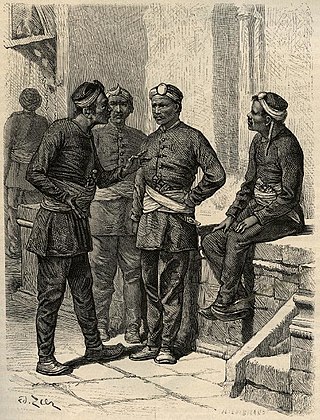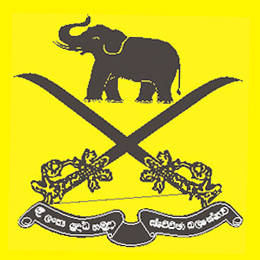Related Research Articles

The King's Royal Rifle Corps was an infantry rifle regiment of the British Army that was originally raised in British North America as the Royal American Regiment during the phase of the Seven Years' War in North America known in the United States as 'The French and Indian War.' Subsequently numbered the 60th Regiment of Foot, the regiment served for more than 200 years throughout the British Empire. In 1958, the regiment joined the Oxfordshire and Buckinghamshire Light Infantry and the Rifle Brigade in the Green Jackets Brigade and in 1966 the three regiments were formally amalgamated to become the Royal Green Jackets. The KRRC became the 2nd Battalion, Royal Green Jackets. On the disbandment of the 1st Battalion, Royal Green Jackets in 1992, the RGJ's KRRC battalion was redesignated as the 1st Battalion, Royal Green Jackets, eventually becoming 2nd Battalion, The Rifles in 2007.

Brigade of Gurkhas is the collective name which refers to all the units in the British Army that are composed of Nepalese Gurkha soldiers. The brigade draws its heritage from Gurkha units that originally served in the British Indian Army prior to Indian independence, and prior to that served for the East India Company. The brigade includes infantry, engineering, signal, logistic and training and support units. They are known for their khukuri, a distinctive heavy knife with a curved blade, and have a reputation for being fierce and brave soldiers.

The Gurkhas or Gorkhas, with the endonym Gorkhali, are soldiers native to the Indian subcontinent, chiefly residing within Nepal and some parts of North India.

The Royal Military Academy Sandhurst, commonly known simply as Sandhurst, is one of several military academies of the United Kingdom and is the British Army's initial officer training centre. It is located in the town of Sandhurst, Berkshire, though its ceremonial entrance is in Camberley, Surrey, southwest of London. The academy's stated aim is to be "the national centre of excellence for leadership". All British Army officers, including late-entry officers who were previously Warrant Officers, as well as other men and women from overseas, are trained at the academy. Sandhurst is the British Army equivalent of the Britannia Royal Naval College and the Royal Air Force College Cranwell.

The Royal Military College (RMC), founded in 1801 and established in 1802 at Great Marlow and High Wycombe in Buckinghamshire, England, but moved in October 1812 to Sandhurst, Berkshire, was a British Army military academy for training infantry and cavalry officers of the British and Indian Armies.
The Officers' Training Corps (OTC), more fully called the University Officers' Training Corps (UOTC), are military leadership training units operated by the British Army. Their focus is to develop the leadership abilities of their members whilst giving them an opportunity to take part in military life whilst at university. OTCs also organise non-military outdoor pursuits such as hill walking and mountaineering. UOTC units are not deployable units nor are their cadets classed as trained soldiers until completion of MOD 1 training. The majority of members of the UOTC do not go on to serve in the regular or reserve forces.

The Indian Army during British rule, also referred to as the British Indian Army, was the main military force of the British Indian Empire until 1947. It was responsible for the defence of both British India and the princely states, which could also have their own armies. As quoted in the Imperial Gazetteer of India, "The British Government has undertaken to protect the dominions of the Native princes from invasion and even from rebellion within: its army is organized for the defence not merely of British India, but of all possessions under the suzerainty of the King-Emperor." The Indian Army was an important part of the forces of the British Empire, in India and abroad, particularly during the First World War and the Second World War.

The Royal Gurkha Rifles (RGR) is a rifle regiment of the British Army, forming part of the Brigade of Gurkhas. Unlike other regiments in the British Army, RGR soldiers are recruited from Nepal, which is neither a dependent territory of the United Kingdom nor a member of the Commonwealth.

A battle honour is an award of a right by a government or sovereign to a military unit to emblazon the name of a battle or operation on its flags ("colours"), uniforms or other accessories where ornamentation is possible.
Junior commissioned officer (JCO) is a group of military ranks which is higher than havildar and lower than lieutenant. The term is only used by Nepal, Bangladesh, India, and Pakistan. Senior havildars are promoted to JCO rank on the basis of merit and seniority, restricted by the number of vacancies. JCOs are treated as a separate class and hold additional privileges. Primarily the term was associated with armies but since the 2000s India's and Pakistan's navies and air forces are using the term to indicate their chief petty officers and warrant officers.
A viceroy's commissioned officer (VCO) was a senior Indian member of the British Indian Army. VCOs were senior in rank to warrant officers in the British Army, and held a commission issued by the viceroy. Also known as "Indian officers" or "native officers", they had authority only over Indian troops and were subordinate to all British King's commissioned officers, Indian Commissioned Officers (ICO) and King's commissioned Indian officers (KCIO).
A King commissioned Indian officer (KCIO) was an Indian officer of the British Indian Army who held a full King's commission after training in the United Kingdom, either at the Royal Military College, Sandhurst for infantry officers, Woolwich for artillery officers, and Chatham and Woolwich for engineer officers. They had full command over British and Indian troops and officers. In contrast, the Indian commissioned officers (ICOs), who were trained at the Indian Military Academy at Dehra Dun, and the Viceroy's commissioned officers (VCOs), only had authority over Indian troops and officers. KCIOs were introduced in the early 20th century under the Indianisation process. They were equivalent in every way to the British officers holding a King's commission. In essence, they were commissioned by the King himself at a special induction ceremony. They held the same ranks and privileges as British officers. In fact, most KCIOs served on attachment to a British unit for a year or two early in their careers.

The Rashtriya Indian Military College is a military school for boys situated in Doon Valley, Dehradun in India. The RIMC is a feeder institution for the National Defence Academy, Indian Naval Academy and subsequently the Indian Armed Forces. Rimcollians, the name by which alumni of the RIMC are usually denoted, have gone on to hold the highest ranks in the Army, Navy and the Air Force of India, Pakistan and Bangladesh.
The Indian Army, the land component of the Indian Armed Forces, follows a certain hierarchy of rank designations and insignia derived from the erstwhile British Indian Army (BIA).

The King's Guard is a ceremonial designation given by the Monarchy of Thailand to the various units within the Royal Thai Armed Forces. Practical and real security of the Royal family has since 1992 been provided by the Royal Security Command, which is an agency that is completely independent of the armed forces.

The Sri Lanka Army is the oldest and largest of the Sri Lanka Armed Forces. The army was officially established as the Ceylon Army in 1949, though the army traces it's roots back in 1881 when Ceylon Light Infantry Volunteers was created; the army was renamed as the 'Sri Lanka Army' when Sri Lanka became a republic in 1972. In 2024, the Army had approximately 150,000 personnel.

The Sri Lanka Army Volunteer Force (SLAVF) is the active-duty volunteer reserve force of the Sri Lanka Army. The SLAVF is separate from the Regular Force which consists of personal who are professional soldiers and its Regular Reserve, which comprises personal who have a mobilization obligation following their service in the regular army. The SLAVF consists of the volunteer force and the volunteer reserve; administration and recruitment of reserve personal is carried out by the Volunteer Force Headquarters in Shalawa, Kosgama which is headed by the Commandant of the Volunteer Force. It has a current strength of about 55,000 personnel. The SLAVF was known as the Ceylon Volunteer Force from 1949 to 1972 and the Sri Lanka Volunteer Force from 1972 to 1985.
General Sir John Francis Stanhope Duke Coleridge was a senior British Indian Army officer who went on to be Military Secretary to the India Office.

Major-General Sir Philip Charles Palin was an officer of the British Indian Army who served in frontier campaigns and then commanded British, Indian and South African troops in Egypt, Gallipoli and Palestine during World War I. Postwar he chaired an inquiry into the Arab–Jewish conflict in Jerusalem.
The Imperial Cadet Corps (1901–1917) was a cadet corps or military school founded exclusively to give officer training to the princes and gentlemen of British India. It was founded in November 1901 under the direct surveillance of Lord Curzon at Meerut and Dehradun. Major D. H. Cameroon was made its first commandant and Maharaja Pratap Singh of Idar was made its Honorary Commandant. The youths between 17 and 20 years were selected and admitted as Imperial Cadets; their education was to be at any one of the Chief's college at Rajkot, Indore, Lahore, Ajmer or Raipur. The selected cadets had to join the corps at Meerut or Dehradun. Though the ICC failed in course of time and was closed in 1917, it nevertheless established the precedent for the officer training of Indians in India, which resulted in the founding of the Indian Military Academy at Dehradun in 1932.
References
- ↑ C.S. Sundaram, "Reviving a 'Dead Letter': Military Indianization and the Ideology of Anglo-India, 1885-1891", in P.S. Gupta and A. Deshpande, eds., The British Raj and its Indian Armed Forces, 1857-1939, New Delhi: Oxford University Press, 2002, pp. 45-97
- ↑ C.S. Sundaram, "'Treated with Scant Attention: the Imperial Cadet Corps, Indian Nobles, and Anglo-Indian Policy, 1897-1917", Journal of Military History, vol. 77, no. 1, Jan. 2013, pp. 41-70.
- ↑ C.S. Sundaram, The Other August Declaration: the Origins of the Indianization of the Indian Army's Officer Corps, 1817-1917, Solihull, UK: Helion, 2015, ch. 5.
- 1 2 3 Khanduri, Chandra B. (2006). Thimayya: an amazing life. New Delhi: Knowledge World. p. 394. ISBN 978-81-87966-36-4 . Retrieved 30 July 2010.
- ↑ We Were There. MOD website Archived 2 October 2008 at the Wayback Machine
- ↑ "Documents – India 1930 - 1947".
- ↑ Peter Hopkirk, 1982, "Trespassers on the Roof of the World: The Race for Lhasa", Oxford University Press.
- 1 2 Derek J. Waller, 2004, "The Pundits: British Exploration of Tibet and Central Asia," University Press of Kentucky.
- 1 2 Account of the Pundit's Journey in Great Tibet - Capt. H. Trotter, The Journal of the Royal Geographical Society (1877).
- ↑ Clements R. Markham, 1878, "A Memoir on The Indian Surveys", 2nd Ed., W H Allen & Co., London, p.189.
- ↑ Charles E. D. Black, 1891, "A Memoir on The Indian Surveys (1875-90)" , London , p.168.